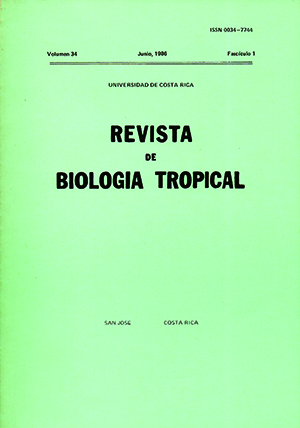Resumen
In the herbaceous community of Parque del Este, in the Central Valley, Costa Rica, the Compositae represent nearly 30% of the total species. Phenological data were collected in a two-year period in eleven of the common species, showing that one is a rainy-season bloomer (Coniza apurensis), two are active all year (Calinsoga parviflora and Calyptocarpus vialis) and in nine, reproduction is concentrated in the dry season (fig. 1). This preference for dry weather might be related with mean s for seed dispersal, mainly by anemochory and ectozoochory.Citas
Burtt, L. 1961. Compositae and the study of functional evolution. Trans. Bot. Soc. Edinburg, 39: 216-232.
Good, R.D. 1931. Some evolutionary problems presented by certain members of the Compositae. J. Bot., 49: 299-305.
Pijl L. van der, 1982. Principles of Dispersal in Higher Plants (III ed.). Springer-Verlag, Berlín. 214 p.
Ramia, M. 1977. Observaciones fenológicas en las sabanas del Medio Apure. Acta. Bot. Venezuela, 12: 72-206.
Ramia, M. 1978. Observaciones fenológicas en las sabanas del Alto Apure. Bol. Soc. Venezuela Cie. Nat., 33: 149-198.
Ramia, M., & f. Delascio. 1982. Ecología de las sabanas del Estado de Cojedes: Reconocimiento florístico y fenológico. Mem. Soc. Cie. Nat. La Salle, 42: 62- 134.
Tosi. J. A. 1969. Mapa Ecológico, República de Costa Rica. Centro Científico Tropical, San José, Costa Rica.
Valerio, C.E. 1983. Anotaciones sobre la historia natural de Costa Rica. Editorial UNED, San José, Costa Rica. 152 p.
Weston. A. S. 1961. The vegetation of disturbed habitats in Costa Rica. Tesis, University of California. 490 p.
Comentarios

Esta obra está bajo una licencia internacional Creative Commons Atribución 4.0.
Derechos de autor 1986 Revista de Biología Tropical


